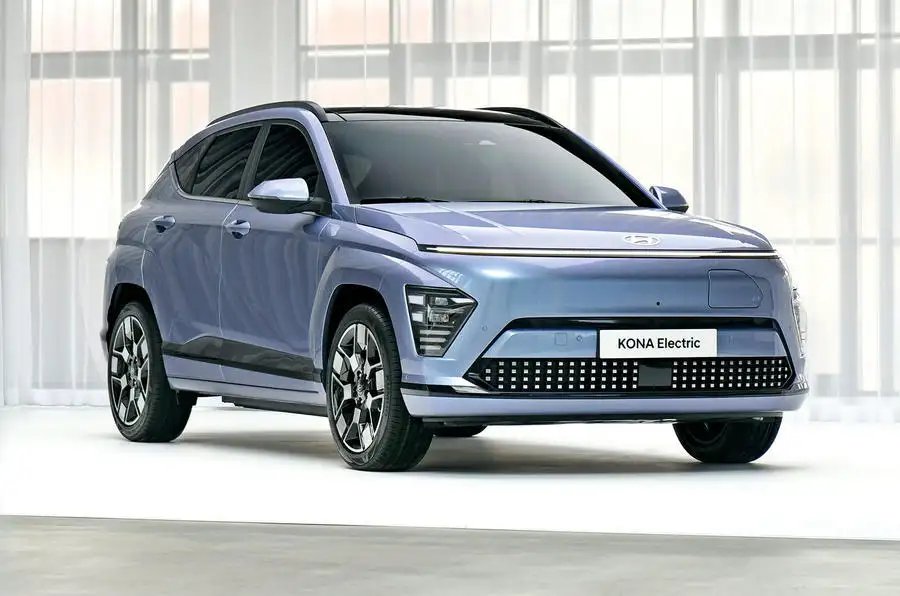New 2023 Hyundai Kona Electric brings 223-mile range for £35k

The new 2023 Hyundai Kona Electric will be priced from £34,995 when it arrives in the UK later this year.
The new second-generation crossover EV has been “taken to the next level” through a focus on the electric version and learnings from the Hyundai Ioniq 5 and Hyundai Ioniq 6.
The new Kona will continue to be offered with petrol, hybrid and electric versions, but while the original was developed originally as an ICE car, electric power was the priority this time.
The EV accounted for around 40% of Kona sales in Europe, and with the continent fast moving to EVs, that ratio will increase sharply in future.
Hyundai design chief SangYup Lee said the focus was on "upscaling" the car in both size and quality.
The Peugeot 2008 rival has switched to a new multi-powertrain platform and grown substantially. At 4355mm long, the new Kona is 175m longer than its predecessor. It's also 25mm wider and 20mm higher, while the wheelbase has been stretched by 60mm.
That makes it slightly smaller than the closely related Kia Niro EV, leaving the Bayon as the smallest crossover in the Hyundai line-up.
The new Kona's bodywork has been honed for aerodynamic efficiency using lessons learned from the development of the Ioniq 6, while on the EV the light bar that runs across the front features the pixel design elements that are a signature of Hyundai’s EVs, having first appeared on the Ioniq 5.
Wheels will range in size from 18in to 19in.
The larger platform also means there's considerably greater interior room, with a major focus to increase the perceived quality of the trim and materials.
The EV features a flat floor, which is rare in a multi-powertrain machine, allowing for a large centre console and a ‘curveless’ bench seat in the rear.
The boot meanwhile has grown by 92 litres to 466 litres.
The driver controls have been relocated to from the centre console to a steering column stalk, while the dashboard features a pair of 12.3in screens. There is also an optional 12in head-up display.
The Kona EV will be offered with two powertrains: the Standard version has a 154bhp motor and 48.4kWh battery (up from 134bhp and 39kWh), while the Long Range model retains a 65.4kWh motor but with its output raised by 13bhp to 214bhp.
The Standard model has an official range of 223 miles, rising to 319 for the Long Range model. That is a small increase on the previous Kona, despite the new car being larger and more powerful. A higher fast-charge-rate ceiling of 102kW (up 27kW on the outgoing model) should cut its 10-80% charge time to around 40 minutes. It retains a 400V architecture.
The Standard Range model receives a single electric motor outputting 154bhp and 188lb ft, while the Long Range variant receives a punchier 215bhp unit with the same torque yield. They dispatch the 0-62mph sprint in 8.8sec and 7.8sec, respectively.
The Kona will be produced in both South Korea and Czechia, with the latter set to provide all UK models for the first time. The ICE and HEV versions will arrive in the coming months, with the EV due to reach the UK in late summer.
Petrol models start at £25,725, while the EV detailed above starts at £34,995.
A Long Range EV in Advance trim is £38,595, and higher trim levels only feature the larger battery. Upgrading to the sportier N Line variant costs £40,395; N Line S and Ultimate are both £43,095.
Hyundai design chief shares his favourite Kona highlights
Dashboard: “The interior really shows what we mean by ‘upscale’. We used two 12.3in screens to create a panoramic display screen, which is really important with our infotainment system.”
Front light bar: “The seamless surround for the lights is one piece. That’s a very expensive execution, especially for this segment. It makes the surface so clean and uninterrupted.”
Seats: “The interior space of a car is becoming a new living space – so let’s do the interior more like furniture rather than traditional automotive design. It’s furniture, but everything is functional.”
Aerodynamics: “The front is really about aerodynamics and we developed it in the wind tunnel. It’s very smooth and sleek, with a drag coefficient of 0.26. We’ve been able to apply lessons from the Ioniq 6 to other vehicles – and the Kona is one of them.”
Centre console: “Moving the driving selector to the steering wheel frees up the central storage space and creates a lot of really useful space.”
Bodywork: “The side is not so critical for aero, so we could play with the sharpness. It’s like Jekyll and Hyde with the volume of the surface.”
